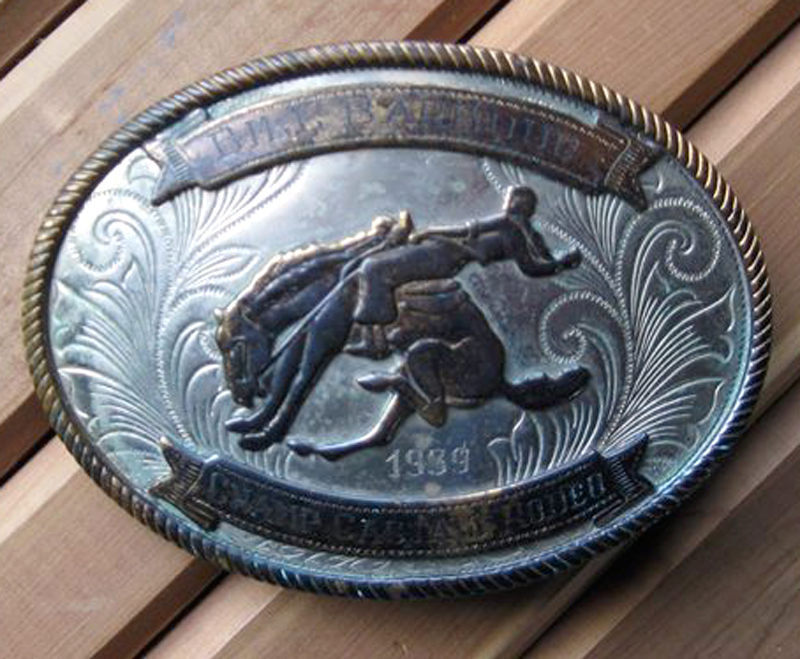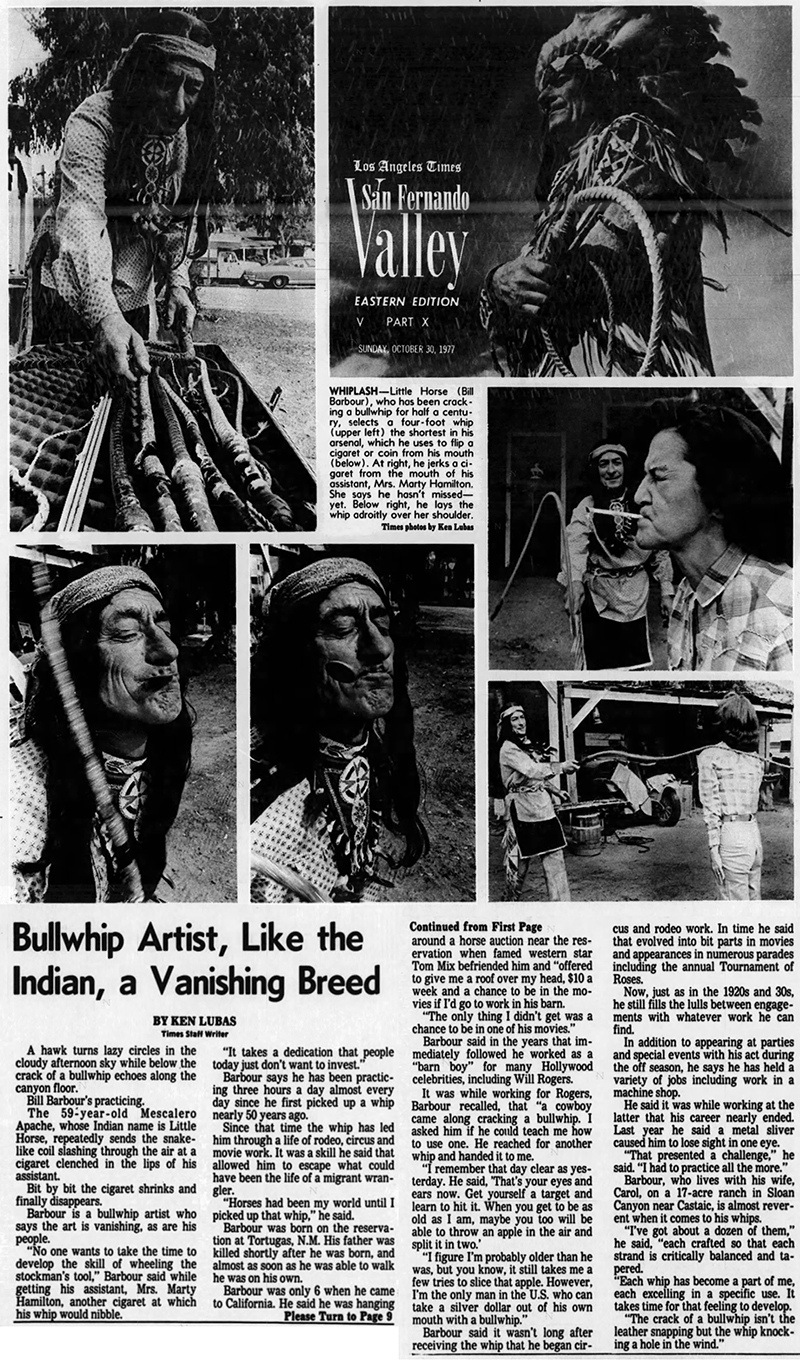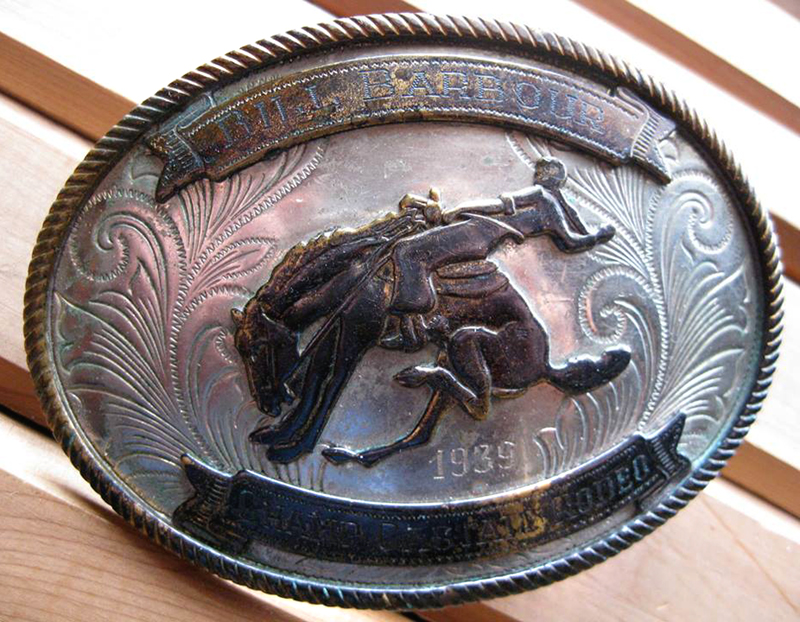|

Another view. Click to enlarge.
|
Bill Barbour's silver championship buckle from the 1939 Castaic Rodeo.
According to photo contributor Glenn Hays, Barbour, alias Chief Little Horse, gave the buckle to Hays' father, Edward G. Hays, who owned Newhall-Saugus Glass Co. from 1964 to about 1990.
"They were friends back then (in the 1970s) — members of the American Legion, Optimist, Moose, Lions Club, etc.,"
Glenn Hays writes. "I remember him dressing up" in regalia, and he was "an expert with the bull whip. He would put out people's cigarettes while they were in their mouths."
Buckle donated by Glenn Hays (Hart High 1977) to the Santa Clarita Valley Historical Society, June 2020.
|
A Mescalero Apache, Bill Barbour, aka Chief Little Horse, was born Haigood Foch Barbour (alternately Highood) on June 15, 1920, in Harnett, N.C., to Lawrence Duffy Barbour and Corena C. Hartsoe Barbour. He had two sisters, Linda Greson and Grace Beasley.
A silver belt buckle indicates he was the champion of the 1939 Castaic Rodeo; he would have been no more than 19 at the time. We're still compiling information about him, but it appears Bill Barbour served in the Army during World War II.
At some point he settled at 30335 Sloan Canyon Road in Castaic, where a 1,403-square-foot, 1+1 home (possibly a homestead cabin) had been built in 1913.
Barbour married Carol J. Gundlach on June 28, 1963. He was involved in several fraternal organizations and participated in regional parades in full Indian regalia (including Newhall, Chatsworth and the Pasadena Tournament of Roses Parade) through the early 1970s. He had a whip act and participated in other rodeos (including Bakersfield).
Barbour retired to Benton, Ark., and died in Little Rock on Aug. 28, 2004. He is buried in the Arkansas Veterans Cemetery in North Little Rock, Pulaksi County, Ark.

Click image to enlarge.
Bullwhip Artist, Like the Indian, a Vanishing Breed.
Los Angeles Times | Sunday, October 30, 1977.
A hawk turns lazy circles in the cloudy afternoon sky while below the crack of a bullwhip echoes along the canyon floor.
Bill Barbour's practicing.
The 59-ycar-old Mescalero Apache, whose Indian name is Little Horse, repeatedly sends the snakelike coil slashing through the air at a cigaret clenched in the lips of his assistant.
Bit by bit the cigaret shrinks and finally disappears.
Barbour is a bullwhip artist who says the art is vanishing, as are his people.
"No one wants to take the time to develop the skill of wheeling the stockman's tool," Barbour said while getting his assistant, Mrs. Marty Hamilton, another cigaret at which his whip would nibble.
"It takes a dedication that people today just don't want to invest."
Barbour says he has been practicing three hours a day almost every day since he first picked up a whip nearly 50 years ago.
Since that time, the whip has led him through a life of rodeo, circus and movie work. It was a skill he said that allowed him to escape what could have been the life of a migrant wrangler.
"Horses had been my world until I picked up that whip," he said.
Barbour was born on the reservation at Tortugas, N.M. His father was killed shortly after he was born, and almost as soon as he was able to walk, he was on his own.
Barbour was only 6 when he came to California. He said he was hanging around a horse auction near the reservation when famed western star Tom Mix befriended him and "offered to give me a roof over my head, $10 a week and a chance to be in the movies if I'd go to work in his barn.
"The only thing I didn't get was a chance to be in one of his movies."
Barbour said in the years that immediately followed, he worked as a "barn boy" for many Hollywood celebrities, including Will Rogers.
It was while working for Rogers, Barbour recalled, that "a cowboy came along cracking a bullwhip. I asked him if he could teach me how to use one. He reached for another whip and handed it to me.
"I remember that day clear as yesterday. He said, 'That's your eyes and ears now. Get yourself a target and learn to hit it. When you get to be as old as I am, maybe you, too, will be able to throw an apple in the air and split it in two.'
"I figure I'm probably older than he was, but you know, it still lakes me a few tries to slice that apple. However, I'm the only man in the U.S. who can take a silver dollar out of his own mouth with a bullwhip."
Barbour said it wasn't long after receiving the whip that he began circus and rodeo work. In time, he said, that evolved into bit parts in movies and appearances in numerous parades including the annual Tournament of Roses.
Now just as in the 1920s and 30s, he still fills the lulls between engagements with whatever work he can find.
In addition to appearing at parties and special events with his act during the off season, he says he has held a variety of jobs including work in a machine shop.
He said it was while working at the latter that his career nearly ended. Last year, he said, a metal sliver caused him to lose sight in one eye.
"That presented a challenge," he said. "I had to practice all the more."
Barbour, who lives with his wife, Carol, on a 17-acre ranch in Sloan Canyon near Castaic, is almost reverent when it comes to his whips.
"I've got about a dozen of them," he said, "each crafted so that each strand is critically balanced and tapered.
"Each whip has become a part of me, each excelling in a specific use. It takes time for that feeling to develop.
"The crack of a bullwhip isn't the leather snapping but the whip knocking a hole in the wind."
HB3901a: 19200 dpi jpeg from digital image by Glenn Hays.



